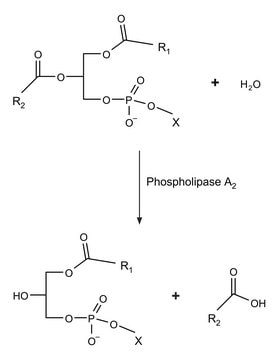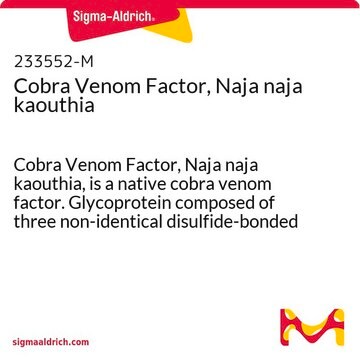V7000
Snake venom from Crotalus atrox (Western Diamondback Rattlesnake)
Synonim(y):
Crotalus atrox Venom, Rattlesnake Venom, Western Diamondback Rattlesnake Venom
Zaloguj sięWyświetlanie cen organizacyjnych i kontraktowych
About This Item
Polecane produkty
Poziom jakości
temp. przechowywania
−20°C
Zastosowanie
Snake venom from Crotalus atrox (Western Diamondback Rattlesnake) has been used:
- in phosphodiesterase 3 (PDE3) and phosphodiesterase 4 (PDE4) inhibition assay
- in the reaction mixture for PDE3B assay
- in PDE assay
- to convert all nucleoside- 5′-monophosphate to guanosine and inorganic phosphate
This page may contain text that has been machine translated.
Hasło ostrzegawcze
Danger
Zwroty wskazujące rodzaj zagrożenia
Zwroty wskazujące środki ostrożności
Klasyfikacja zagrożeń
Acute Tox. 1 Inhalation - Acute Tox. 2 Dermal - Acute Tox. 2 Oral
Kod klasy składowania
6.1A - Combustible acute toxic Cat. 1 and 2 / very toxic hazardous materials
Klasa zagrożenia wodnego (WGK)
WGK 3
Temperatura zapłonu (°F)
Not applicable
Temperatura zapłonu (°C)
Not applicable
Certyfikaty analizy (CoA)
Poszukaj Certyfikaty analizy (CoA), wpisując numer partii/serii produktów. Numery serii i partii można znaleźć na etykiecie produktu po słowach „seria” lub „partia”.
Masz już ten produkt?
Dokumenty związane z niedawno zakupionymi produktami zostały zamieszczone w Bibliotece dokumentów.
Augmentation of lipolysis in adipocytes from fed rats, but not from starved rats, by inhibition of rolipram-sensitive phosphodiesterase 4
Nakamura J, et al.
Archives of Biochemistry and Biophysics, 425(1), 106-114 (2004)
Insulin-induced phosphorylation and activation of cyclic nucleotide phosphodiesterase 3B by the serine-threonine kinase Akt
Kitamura T, et al.
Molecular and Cellular Biology, 19(9), 6286-6296 (1999)
Photoreceptor phosphodiesterase: interaction of inhibitory gamma subunit and cyclic GMP with specific binding sites on catalytic subunits
Artemyev N O, et al.
Methods, 14(1), 93-104 (1998)
Hunseung Yoo et al.
Journal of ethnopharmacology, 206, 298-305 (2017-05-17)
Sophora tonkinensis (Leguminosae, ST) is a traditional herbal plant in Korea and China. Its roots and rhizomes have been used to dissipate heat, to clear toxic material and to treat acute pharyngolaryngeal infections and sore throats. In this study, we
Nasz zespół naukowców ma doświadczenie we wszystkich obszarach badań, w tym w naukach przyrodniczych, materiałoznawstwie, syntezie chemicznej, chromatografii, analityce i wielu innych dziedzinach.
Skontaktuj się z zespołem ds. pomocy technicznej








